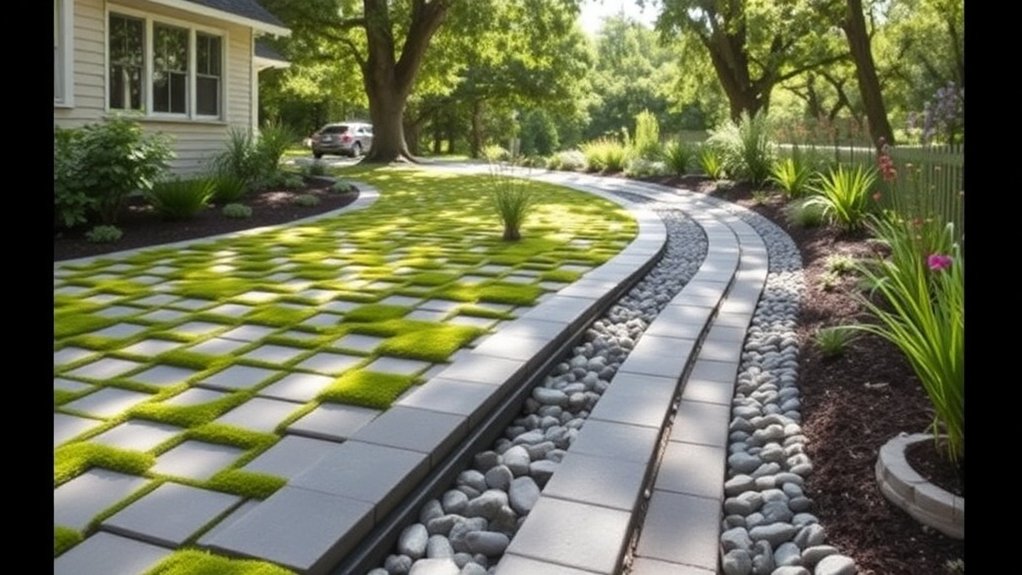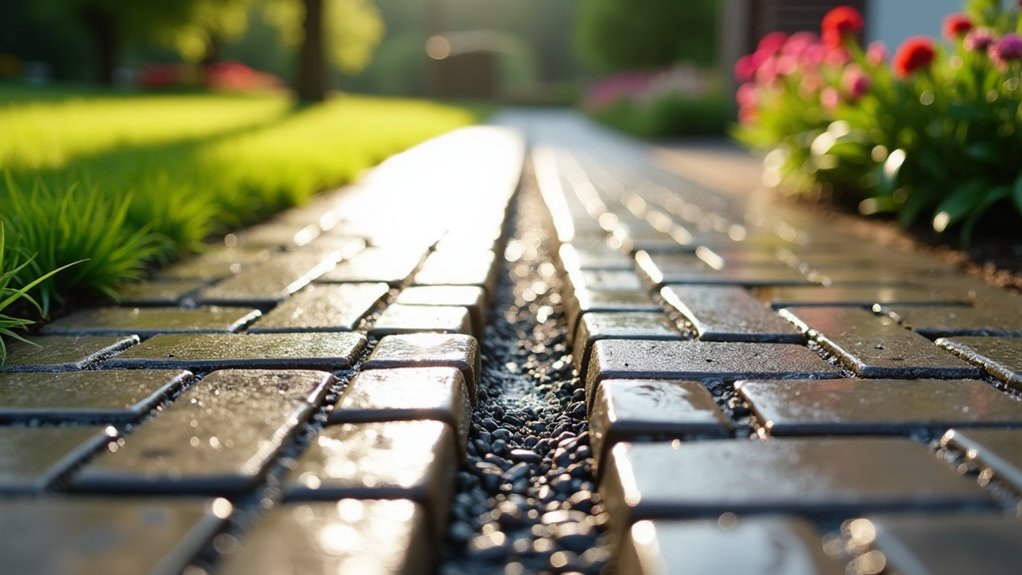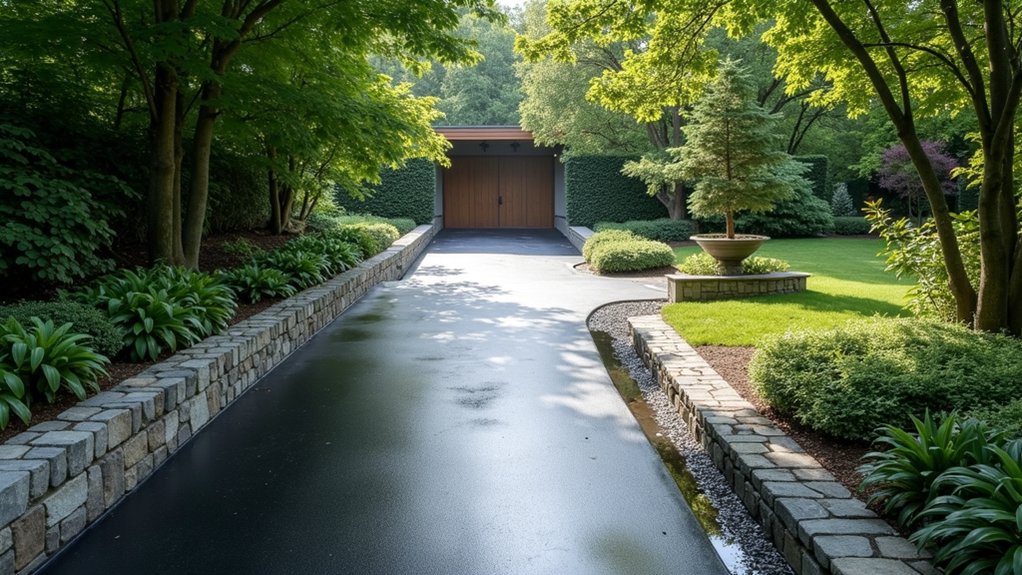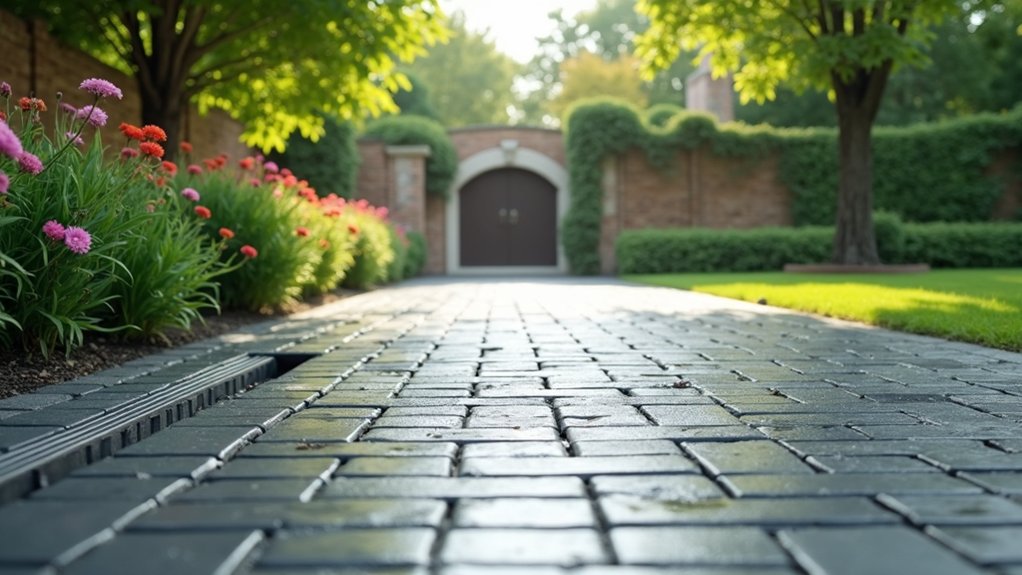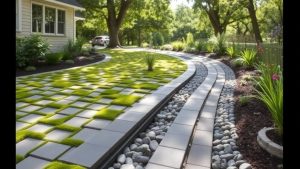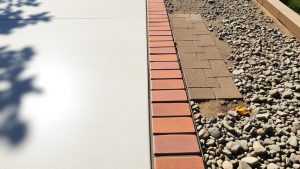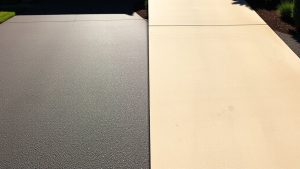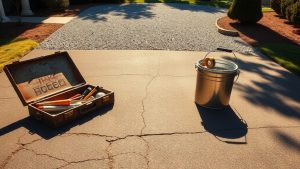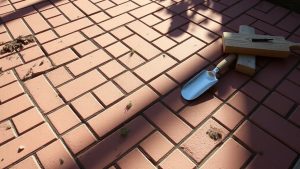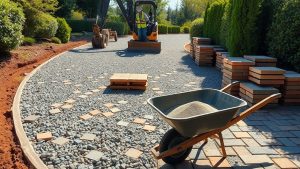For effective driveway drainage in areas prone to high water, ensure proper grading with a minimum slope of 2%, or 3% in areas at risk of flooding. Use a mix of perforated and solid pipes made from materials suitable for heavy traffic. Consider installing channel drains and catch basins to redirect water efficiently. Eco-friendly permeable paving can also help manage runoff. Regular maintenance, such as cleaning and inspections, is essential for keeping your drainage system in good condition. Explore more ways to optimise your drainage solutions.
Table of Contents
ToggleKey Takeaways
- Ensure a minimum slope of 3% on driveways in high-water areas to improve drainage and prevent water pooling.
- Use effective drainage pipe systems, such as HDPE or PVC, to manage runoff efficiently in busy areas.
- Install channel drains to redirect water on sloped driveways, helping to prevent flooding during heavy rain.
- Consider permeable paving options like BaseCore Geocells or porous pavers to promote water infiltration and reduce surface runoff.
- Regularly maintain drainage systems with cleaning and inspections to keep them functioning well and prevent blockages.
Understanding the Importance of Proper Grading
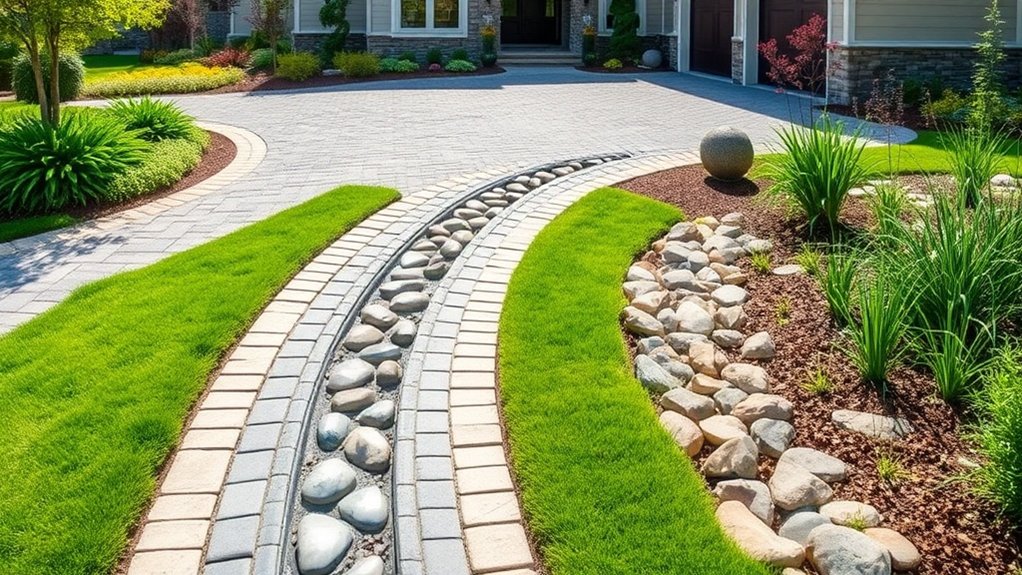
Effective management of water runoff is crucial for any driveway, particularly in areas prone to flooding. Proper grading techniques create a level base with a slight slope, directing water away from both the driveway and the home’s foundation. It’s recommended to maintain a minimum slope of 2% to prevent water pooling, which can lead to erosion and structural issues. In regions with higher water concerns, a slope of 3% may be necessary. Consistent grading helps avoid low spots that hold water, improving the driveway’s durability and lifespan. By following these guidelines, you can reduce maintenance costs, preserve the integrity of your driveway, and increase property value while ensuring safety for both vehicles and pedestrians. Additionally, proper grading is essential for preventing water damage and ensuring long-term stability of the driveway surface. Implementing Sustainable Drainage Systems (SuDS) can further enhance water absorption and mitigate flooding risks.
Effective Drainage Pipe Systems for Driveways
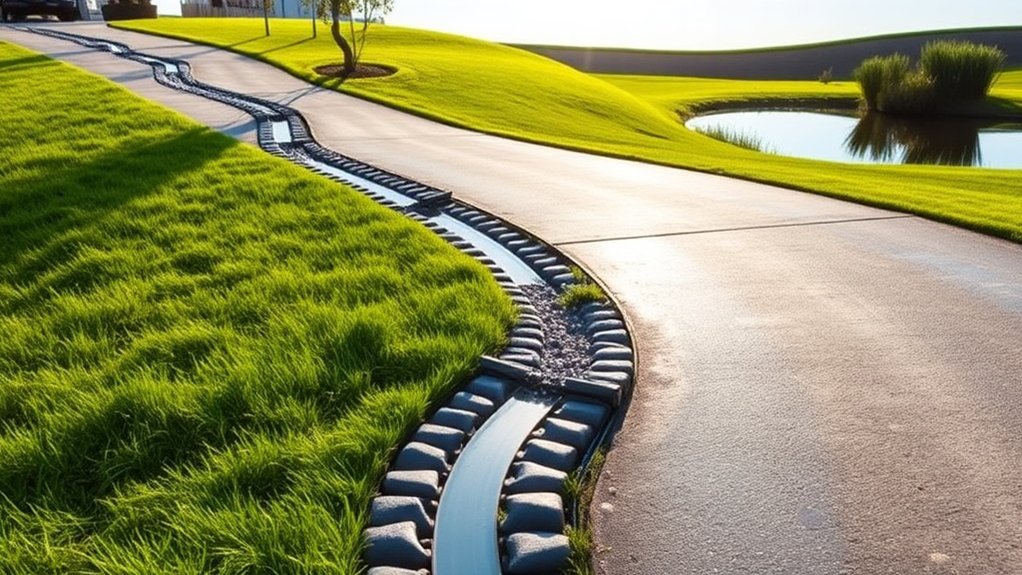
To effectively manage water runoff from your driveway, choosing the right drainage pipe system is crucial. Start by considering materials suited to your local conditions; for example, HDPE is ideal for heavy-duty applications, while PVC works well for standard use. Your drainage design should take into account pipe size and slope to ensure efficient water flow.
Perforated pipes, as found in French drain systems, are great for collecting groundwater, whereas solid pipes are used to transport runoff away from the area. Make sure all fittings in your design are compatible for easy maintenance.
For locations with high traffic, it’s wise to choose Schedule 40 or reinforced HDPE pipes to prevent damage. Effective water management is essential to avoid costly repairs and long-term structural issues with your driveway.
Combining systems, such as catch basins and channel drains, can improve effectiveness, particularly when dealing with larger volumes of water.
Surface Drainage Solutions to Manage Runoff
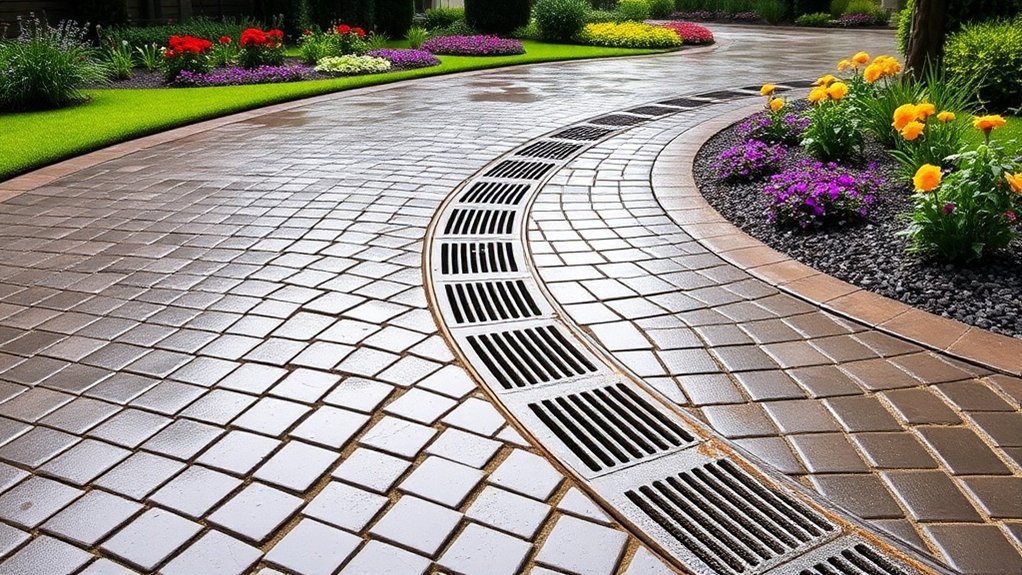
Effective surface drainage solutions are crucial for managing runoff and preventing water pooling on driveways, especially in areas prone to flooding. Options include channel drains, catch basins, and gravel driveways, each designed to redirect water efficiently. Channel drains are particularly effective for sloped driveways, as they capture and redirect water away from the surface. Implementing these solutions is essential for adhering to regulatory requirements that ensure proper drainage management.
| Solution Type | Key Features | Ideal Surface Types |
|---|---|---|
| Channel Drains | Efficient water diversion | Sloped surfaces |
| Catch Basins | Collects large volumes of water | Concrete, asphalt |
| Gravel Driveways | Allows natural water seepage | Gravel, stone |
| Swales | Directs water away | Landscaped areas |
| Surface Slope | Naturally guides water | All driveway surfaces |
Implementing these solutions ensures better water management and reduces the risk of driveway flooding.
Eco-Friendly Permeable Paving Options
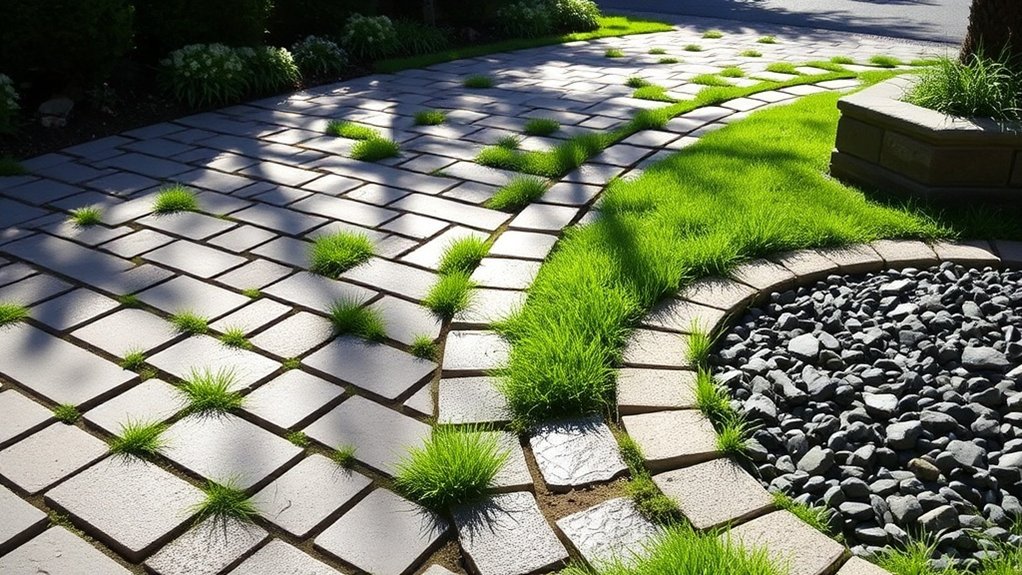
As urban areas face growing challenges with stormwater management, eco-friendly permeable paving options provide a practical solution to reduce runoff and boost groundwater recharge. These sustainable alternatives use environmentally friendly materials that permit water infiltration, thus decreasing surface runoff. Additionally, permeable driveways contribute to groundwater recharge, supporting healthy ecosystems and maintaining natural water cycles.
Here are three effective choices:
- BaseCore Geocells: These lightweight structures stabilise gravel, reducing material usage while encouraging water infiltration.
- Honeycomb-Celled Panels: These interlocking grids support gravel or grass driveways, improving drainage and minimising weed growth.
- Permeable Pavers: Crafted from porous materials, these pavers allow water to pass through, preventing runoff and aiding aquifer recharge.
Choosing the right option can help create greener urban spaces while effectively managing water.
Selecting the Right Capacity for Your Drainage System
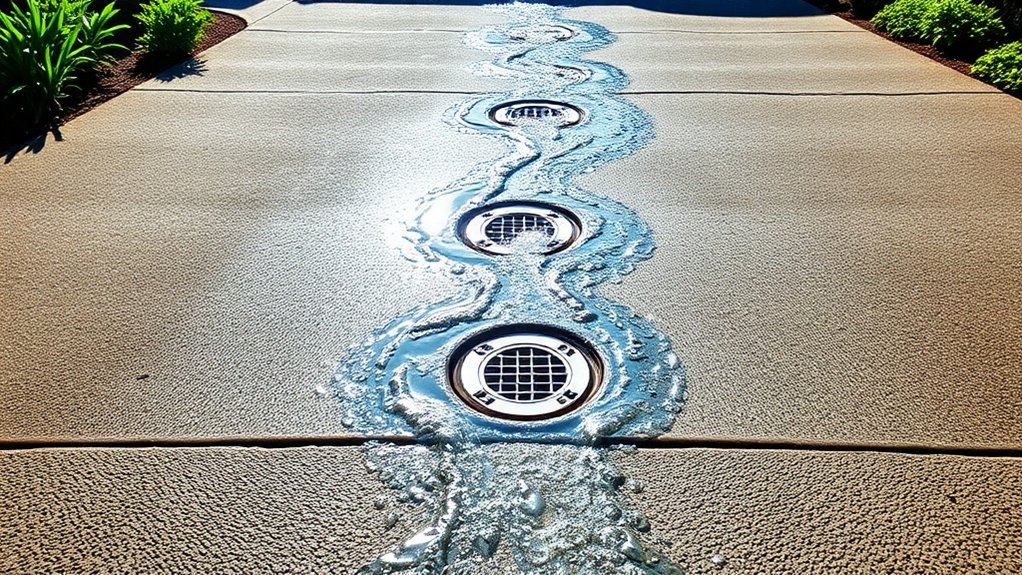
How can you ensure your drainage system copes with heavy rainfall? Start by calculating the runoff volume for your catchment area using local rainfall data. Multiply this by a recommended safety factor of 15 gallons per drainage zone to determine the storage size needed. Refer to manufacturers’ flow capacity tables to compare your calculated runoff against the capacities of various channel drains.
Choosing the right pipe size is crucial. Select from 3”, 4”, or 6” pipes based on peak flow rates:
| Pipe Size | Max Flow Capacity (GPM) | Best Use |
|---|---|---|
| 3” | 44 | Low runoff areas |
| 4” | 75 | Moderate runoff areas |
| 6” | 175 | High runoff conditions |
This approach will help ensure your drainage system has the necessary capacity to handle severe weather.
Maintenance Tips for Long-Lasting Drainage Solutions
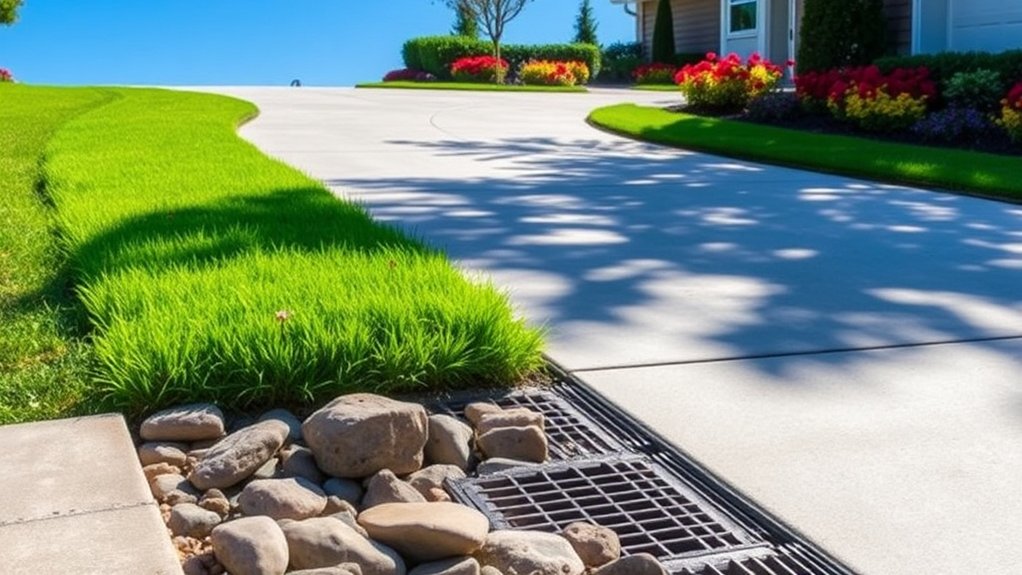
To ensure your drainage system remains effective, carry out regular cleaning and maintenance.
Check grates for wear and tackle any issues promptly to keep everything running smoothly.
Also, keep an eye on the grading stability to avoid water pooling and ensure proper drainage flow.
For instance, if you notice that water isn’t flowing away as it should, it might be time to adjust the grading or clear any blockages.
Regular upkeep can save you from costly repairs down the line.
Regular Drain Cleaning
Regular drain cleaning is vital for keeping your drainage system working efficiently, especially in areas prone to heavy rainfall.
By adopting effective drain cleaning methods during seasonal maintenance, you can prevent blockages and improve performance.
Here are three essential practices:
- Annual Cleaning: Arrange for a comprehensive clean of trench drain systems to ensure they function properly.
- Debris Removal: Frequently remove leaves and dirt to allow water to flow freely and avoid clogs.
- Pressure Washing: Use a pressure washer at least once a season to clear away grime and debris, particularly on gravel and permeable surfaces.
Inspect Grate Conditions
To ensure your drainage system functions properly, it’s crucial to inspect the condition of grates regularly, not just clean the drains. Carry out thorough inspections to spot any cracks, dents, or rust that may affect their strength.
Look for signs of loosening or movement, as these could result in the grate shifting and creating safety risks. If you find any damage, replace the grates promptly to maintain proper debris blocking.
During your inspections, also check for any missing fasteners that secure the grates in place, as their absence can lead to accidental removal during heavy rainfall.
When replacing grates, opt for sturdy materials like galvanised steel or composite plastics that are resistant to corrosion.
Monitor Grading Stability
Monitoring grading stability is crucial to ensure effective drainage, which helps prevent water accumulation and erosion.
Here are some straightforward techniques and tools to keep your driveway in good shape:
- Regular Grading: It’s wise to grade your driveway after heavy rain or when it has seen increased traffic to avoid ruts and bumps.
- Use the Right Tools: A box scraper or landscape rake attached to a small tractor works well, but you can also use a robust landscaping rake for manual grading.
- Check for Crowning: Ensure your driveway has a slight crown to direct water runoff, which enhances drainage.
Frequently Asked Questions
How Do I Assess My Driveway’s Drainage Needs?
To assess your driveway’s drainage needs, start with a water flow analysis. Look at the slope of your driveway and the type of soil it’s made from. Check any existing drainage features, like drains or gullies, and identify sources of runoff, such as nearby grass or flower beds. This will help you spot potential drainage issues and decide what improvements are necessary. For example, if water tends to pool at the bottom of your drive, you might need to install additional drainage channels or adjust the slope.
Can Plants Help With Driveway Drainage Solutions?
When it pours, native plants can significantly improve drainage. Their strong root systems soak up excess water, enhance soil structure, and minimise erosion. This makes them an excellent option for effective driveway drainage solutions. For example, planting species like lavender or wildflowers can help manage water runoff while adding beauty to your property.
What Are the Signs of Poor Driveway Drainage?
Signs of poor driveway drainage include persistent water pooling and erosion. These issues can cause structural damage, surface instability, and safety hazards, highlighting the urgent need for drainage solutions. For example, if you notice water collecting in certain areas after heavy rain, it’s a clear indication that your driveway’s drainage isn’t working properly.
How Often Should I Inspect My Drainage System?
Inspect your drainage system at least twice a year, ideally in spring and autumn. Depending on how frequently you use your drainage, the local weather, and any potential blockages, you may need to adjust this frequency. Staying proactive can help you avoid expensive repairs down the line. For example, if you live in an area with heavy rainfall, you might want to check more often.
Are There DIY Options for Driveway Drainage Improvements?
Yes, you can enhance driveway drainage by installing a drainage channel next to gravel beds. This arrangement directs water effectively, enabling it to filter through the gravel, which reduces pooling and improves overall drainage efficiency.
Conclusion
In areas prone to heavy rainfall, selecting the right driveway drainage solution is essential to prevent water damage. Start by ensuring proper grading to direct water away from your property. Consider installing effective drainage systems, such as soakaways or channel drains, which can help manage excess water. Use materials like permeable paving that allow rainwater to soak through, reducing surface runoff.
Regular maintenance of your drainage system is crucial; keep it clear of debris to ensure it functions effectively. By implementing these strategies, you can protect your driveway and home from the elements, ensuring a dry and safe environment for years to come.
Find effective strategies to prevent water pooling on your driveway and discover essential tips that will keep it dry and Read more
Learn why effective drainage is crucial for driveways and discover the regulations and best practices that could save you costly Read more
Just because your driveway looks great doesn’t mean it’s compliant with UK drainage regulations; discover what you need to know Read more

